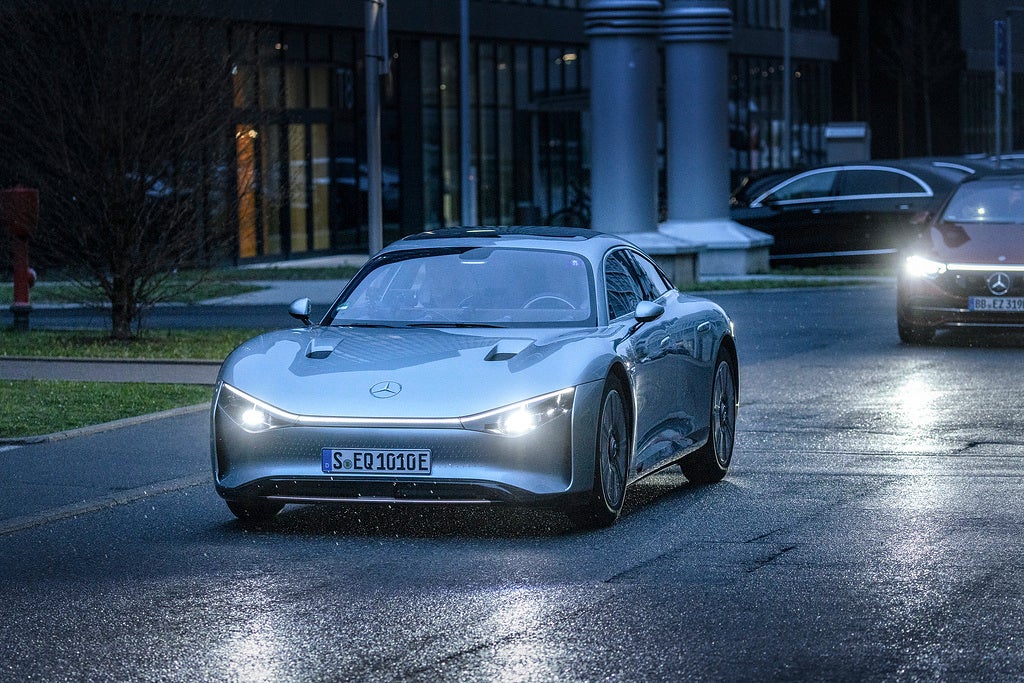
Mercedes-Benz has developed a long-range BEV concept that has managed to cover more than 1,000 km on a single charge. The car comes with a number of technical innovations including a specially developed lightweight battery that is around 30% lighter than an EQS pack. It is also air-cooled rather than liquid.
Travelling from Sindelfingen across the Swiss Alps and Northern Italy, to its destination of Cassis on the Côte d’Azur, the car covered more than 1,000 km in everyday traffic, on a single battery charge.
Mercedes said the battery’s state of charge on arrival was around 15 percent, amounting to a remaining range of around 140 kilometres, and the average consumption was a record-breaking low of 8.7 kWh per 100 kilometres.
Mercedes maintains the ‘new blueprint for automotive engineering has delivered a new benchmark for electric vehicle efficiency and range, and the technology in the VISION EQXX will be deployed in upcoming series-production Mercedes vehicles’.
“We did it! Powering through more than 1,000 kilometres with ease on a single battery charge and a consumption of only 8.7 kWh/100 km in real-world traffic conditions. The VISION EQXX is the most efficient Mercedes ever built. The technology programme behind it marks a milestone in the development of electric vehicles. It underpins our strategic aim to ‘Lead in Electric’,” says Ola Källenius, Chairman of the Board of Management of Mercedes-Benz Group AG.
The VISION EQXX is described by Mercedes as the product of a holistic approach with innovations in all technical areas that have an impact on energy consumption. “With our successful road trip to the South of France, we’ve shown that efficiency is the new currency. And this success also clearly speaks for our new collaborative development process, incorporating many learnings from the Mercedes-AMG F1 team and its cutting-edge expertise in electric powertrains. The VISION EQXX is the result of a comprehensive programme that provides a blueprint for the future of automotive engineering. Many of the innovative developments are already being integrated into production, some of them in the next generation of modular architecture for compact and midsize Mercedes‑Benz vehicles. And the journey continues. With the VISION EQXX, we will keep testing the limits of what’s possible,” says Markus Schäfer, Member of the Board of Management of Mercedes-Benz Group AG, Chief Technology Officer responsible for Development and Purchasing.
The VISION EQXX is described as a software-defined research prototype which is part of a far-reaching technology programme that combines the latest digital technology with Mercedes’ pioneering spirit, the agility of a start-up and the speed of Formula 1. The mission in developing the VISION EQXX was to break through technological barriers across the board.
The lightweight design concept of the VISION EQXX ranges from the materials used to bionic structures that deliver a favourable power-to-weight ratio. Examples of this are the sustainable carbon-fibre-sugar composite material used for the upper part of the battery, which is also used in Formula 1, and the BIONEQXXTM rear floor, manufactured using an aluminium casting process. The light metal structural component replaces a much heavier assembly of several interconnected parts. It has gaps in places where structural strength is not required, thus saving material. This innovative design approach results in a weight saving of up to 20 percent compared to a conventionally manufactured component, Mercedes claims.
A large part of the weight efficiency is also due to the dedicated electric chassis with lightweight F1 subframe and aluminium brake discs. Another is the battery. At 100 kWh, the power storage unit developed specifically for the VISION EQXX has almost the same amount of energy as the battery of the EQS, which is already a global benchmark among electric cars currently on the market. However, it has 50 percent less volume and is 30 percent lighter. The outcome is that the compact battery, measuring just 200 x 126 x 11 cm, is also comparatively light at 495 kilograms and fits in a compact car. The electric drive was developed in cooperation with the experts from Mercedes-AMG Petronas F1 Team.



